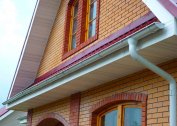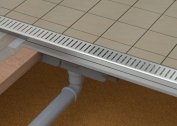In the modern world, the absence of a centralized sewage system in the country has ceased to be a problem. Why carry waste buckets or use expensive services of sewage disposal equipment, if you can install a toilet without a cesspool and permanently get rid of the unpleasant smell and pumping of waste products.
Dry closets
 The dry closet is especially popular among summer residents and residents of private houses that are not connected to a common sewage system. It is not required to establish communications, it can be placed in a house, in a room or in a separate building, it fits freely in the trunk of a car, it is easy to go out with it.
The dry closet is especially popular among summer residents and residents of private houses that are not connected to a common sewage system. It is not required to establish communications, it can be placed in a house, in a room or in a separate building, it fits freely in the trunk of a car, it is easy to go out with it.
The model is compact, easy to assemble, light in weight and easy to operate. It consists of two chambers: the upper one is used as a toilet bowl, and the lower one collects and processes waste. Adding safe environmental additives to the lower chamber, the contents can be poured into the ground without fear for the quality and fertility of the soil. Flushing occurs at the expense of the pump (piston, electric from batteries or pump-action). Thanks to the septic tanks, there is no smell, emptying through the drain pipe. Most models are equipped with an indicator for filling the storage tank. To fix the structure to the floor, you can buy a floor panel.
Prices from 4500 rubles and above.
Disadvantages:
- toxic agents of non-natural origin are most often used, which is harmful to the environment;
- the septic tank is filled after each emptying of the tank;
- frequent acquisition of chemicals;
- at minus temperature, a high probability of moisture freezing in tanks;
- basically the height of the toilet is small.
Electric dry closet
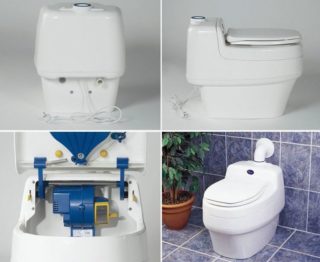 Electric dry closet outwardly no different from a conventional toilet. In the lower tank, the waste is divided into liquid and solid. To remove liquid waste, it is necessary to install a drainage system, solid waste together with toilet paper is dried in a storage chamber to the state of ash. The camera only opens when landing on the toilet. The output products can be used to fertilize plants, preferably not intended for food. There is no smell.
Electric dry closet outwardly no different from a conventional toilet. In the lower tank, the waste is divided into liquid and solid. To remove liquid waste, it is necessary to install a drainage system, solid waste together with toilet paper is dried in a storage chamber to the state of ash. The camera only opens when landing on the toilet. The output products can be used to fertilize plants, preferably not intended for food. There is no smell.
Disadvantages:
- high price;
- installation of a drainage system;
- the availability of electricity.
Electric dry closet for burning waste products. It is used for impossible disposal of products. The destruction of waste is accompanied by a high combustion temperature (550 degrees). The system is protected against overheating. Ash removal is required every five days. Non-waste option.
Disadvantages:
- high price from 100 000 rubles;
- disposable waste bags;
- installation of a ventilation pipe;
- electricity.
There are models of dry closets with deep freezing (up to -18 degrees) of waste in the storage tank, which are placed in biodegradable bags. When emptying, you do not need to move the storage tank, just get the contents. No water and sewage required.
Peat toilet
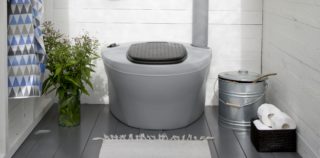 Composted peat toilet without water, electricity and sewage. You can put in the house or instead of the old closet. It has a thermally insulated case, in which there is a quick compost of waste. The built-in ventilation system removes unpleasant odors. A drainage hose is connected to the toilet, which discharges fluid into the tank or gutter on the street. The stable design is convenient for use by full and tall people. The design, weight, volume, mobility of the device depends on the preferences of the buyer. A peat toilet will save on communications and provide the garden with useful compost.It can be used at subzero temperatures. Prices are calculated for the average consumer from 15 thousand and above.
Composted peat toilet without water, electricity and sewage. You can put in the house or instead of the old closet. It has a thermally insulated case, in which there is a quick compost of waste. The built-in ventilation system removes unpleasant odors. A drainage hose is connected to the toilet, which discharges fluid into the tank or gutter on the street. The stable design is convenient for use by full and tall people. The design, weight, volume, mobility of the device depends on the preferences of the buyer. A peat toilet will save on communications and provide the garden with useful compost.It can be used at subzero temperatures. Prices are calculated for the average consumer from 15 thousand and above.
Disadvantages:
- it is worthwhile to carefully approach the installation site, since a ventilation pipe and a drainage system are required.
Electric peat toilet
 Electric odorless peat dry toilet. No water and sewage are needed, only electricity is needed. The device freezes the waste to the temperature of the termination of the reproduction of microbes (-15 degrees). There is a type of toilet in which the waste is dried using a compressor.
Electric odorless peat dry toilet. No water and sewage are needed, only electricity is needed. The device freezes the waste to the temperature of the termination of the reproduction of microbes (-15 degrees). There is a type of toilet in which the waste is dried using a compressor.
Installed anywhere, no odor, designed for a family of up to five people. The device’s tank contains a biodegradable bag that can be sent to compost along with other waste.
Disadvantages:
- high price of the device;
- electricity required.
Powder-closet
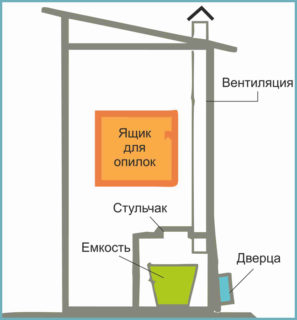 Powder closet or dry Finnish toilet. A container for organic “powder” (ash, sawdust, peat or dry earth) is placed in place of the drain tank. After visiting the restroom, the waste enters the tank - a container, a bucket, a barrel under the toilet and is filled up. As it fills, the contents are sent to a cesspool to ripen the compost.
Powder closet or dry Finnish toilet. A container for organic “powder” (ash, sawdust, peat or dry earth) is placed in place of the drain tank. After visiting the restroom, the waste enters the tank - a container, a bucket, a barrel under the toilet and is filled up. As it fills, the contents are sent to a cesspool to ripen the compost.
Of the advantages - ease of installation and money savings.
Disadvantages:
- frequent maintenance;
- heavy waste container;
- not always an aesthetic appearance;
- ventilation installation;
- long waste processing;
- Compost heap care.
Septic tank
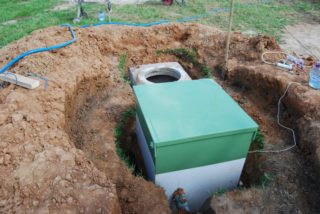 Septic tanks - an autonomous sewage system, a design for draining waste not only from the toilet, but from all the appliances in the house associated with the water and wastewater system (washing machine, dishwasher). To install a septic tank, earthwork is required, since the tanks are always underground, and a pipe is laid from the house to them.
Septic tanks - an autonomous sewage system, a design for draining waste not only from the toilet, but from all the appliances in the house associated with the water and wastewater system (washing machine, dishwasher). To install a septic tank, earthwork is required, since the tanks are always underground, and a pipe is laid from the house to them.
To select the degree of effluent treatment, the soil feature is taken into account. For example, in places where groundwater is located close to the surface or poorly permeable soil, it is not recommended to use models with soil post-treatment. The best option is sandy soil.
You can choose a septic tank without taking into account the soil, based on the method of deep biological treatment. The more expensive and more complex the septic tank system is, the less mechanical cleaning is required.
Disadvantages:
- financial costs for installation and maintenance of equipment;
- connection to water and electricity is required;
- pumping out;
- installation and configuration by specialists.
